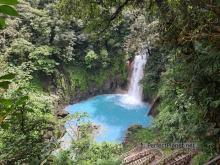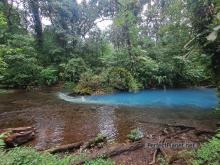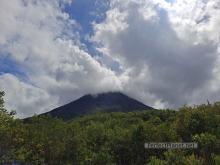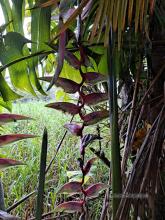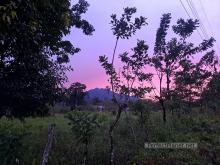We wake up at 5.30 in the morning. It is so early in the morning and the temperature is so pleasant that you get active right away.
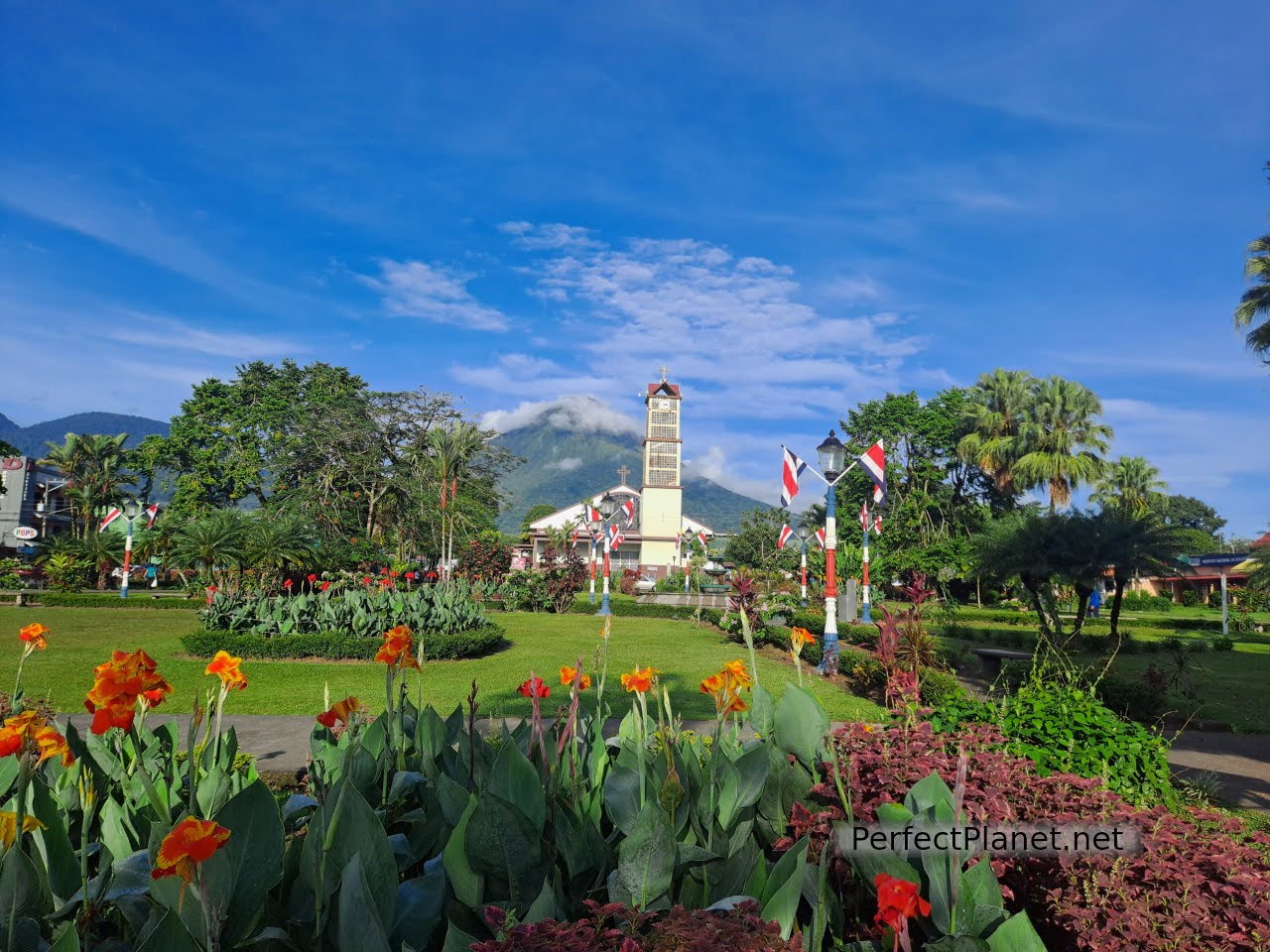
La Fortuna Park
We had breakfast at the bakery La Principal in front of La Fortuna Park, 1 coffee, 2 empanadas and a donut. By the way there is a beautiful picture of La Fortuna Park with the church and the Arenal volcano in the background.
As the park has not yet opened, we first visit the Arenal Lake to get a better view of the volcano, which is somewhat covered today. Lake Arenal, formed by tectonic movements that created a small depression in the valley, is today the largest lake in the country and produces 40% of the energy consumed in Costa Rica.
If windsurfing is your sport, this is the ideal place to practice it as it is among the three best lakes in the world to practice this sport. It is also a perfect place for kayaking, fishing or boating.
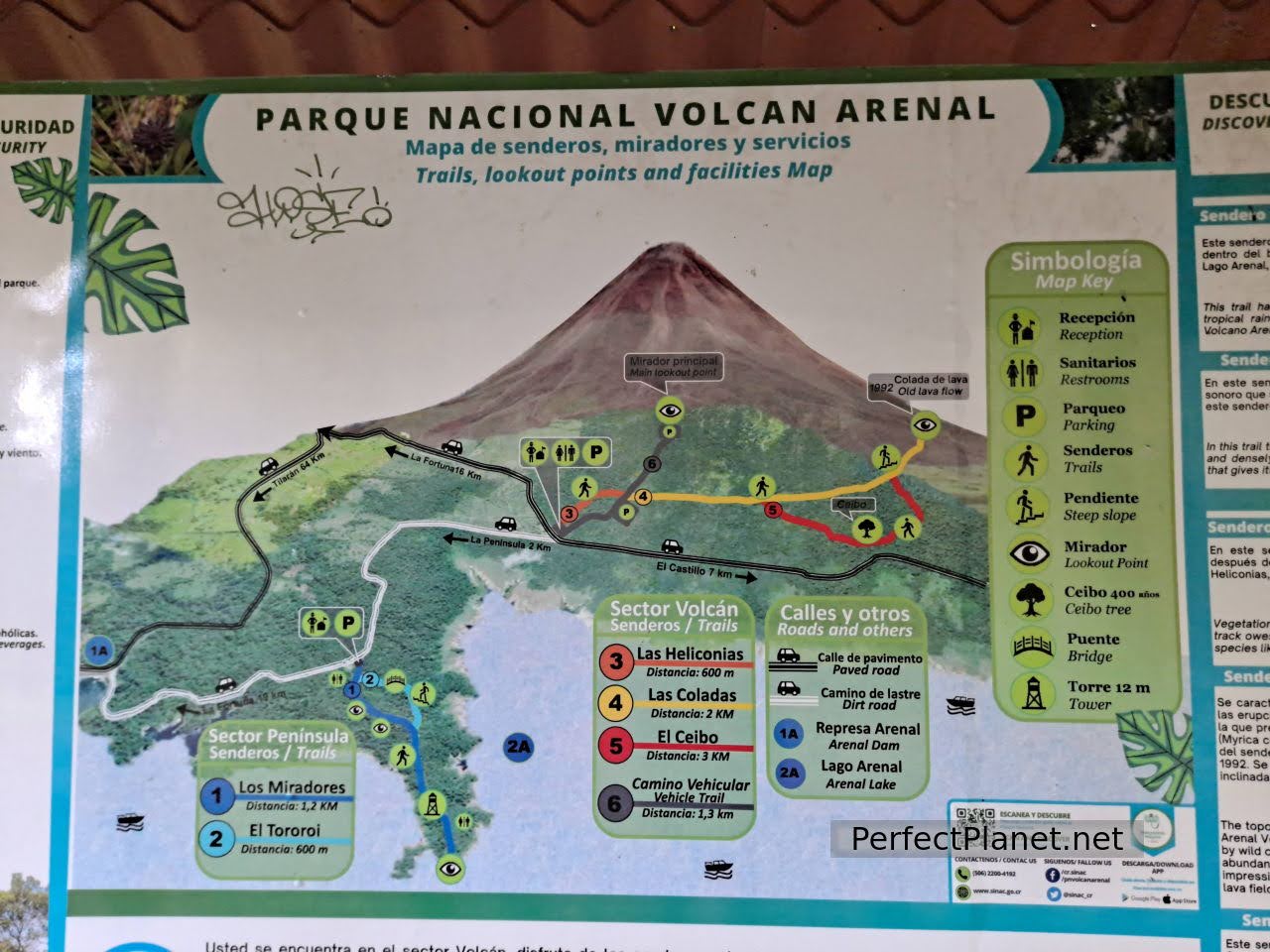
Trails
Our first stop today is the Arenal Volcano National Park. Open from 8 am to 4 pm.
This volcanic colossus, considered one of the youngest in the country, dominates the Tilarán mountain range. In 1968 it had its most devastating eruption causing the destruction of the villages of Tabacón, San Luis and Pueblo Nuevo and the death of almost 90 people. For the next 42 years it was the most active volcano in Costa Rica. Its volcanic activity continues although it has reduced considerably (lava flows could be seen descending its slopes) and since 2010 it has entered a resting phase.
Its almost perfect conical shape (1,653 metres) makes it the main attraction of the area, making it one of the natural wonders of Costa Rica.
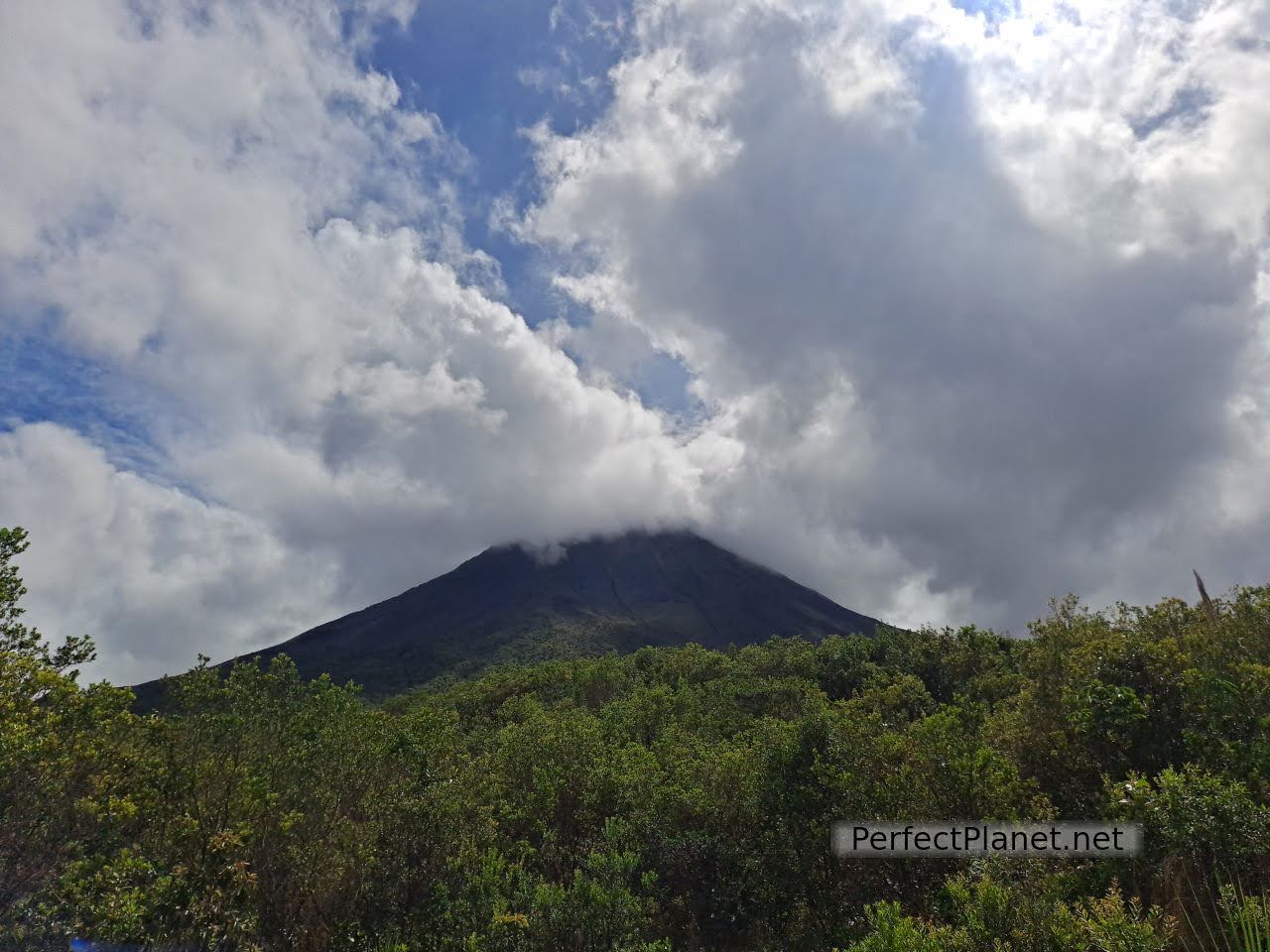
Arenal volcano from lava flows viewpoint
In this park you can visit two sectors, the Peninsula sector next to Lake Arenal and the Volcano sector. The entrance fee is valid for both.
In the Volcano sector you can walk several trails: Heliconias, Coladas, El Ceibo and Mirador. If you don't have much time we recommend the Coladas and Mirador trails.
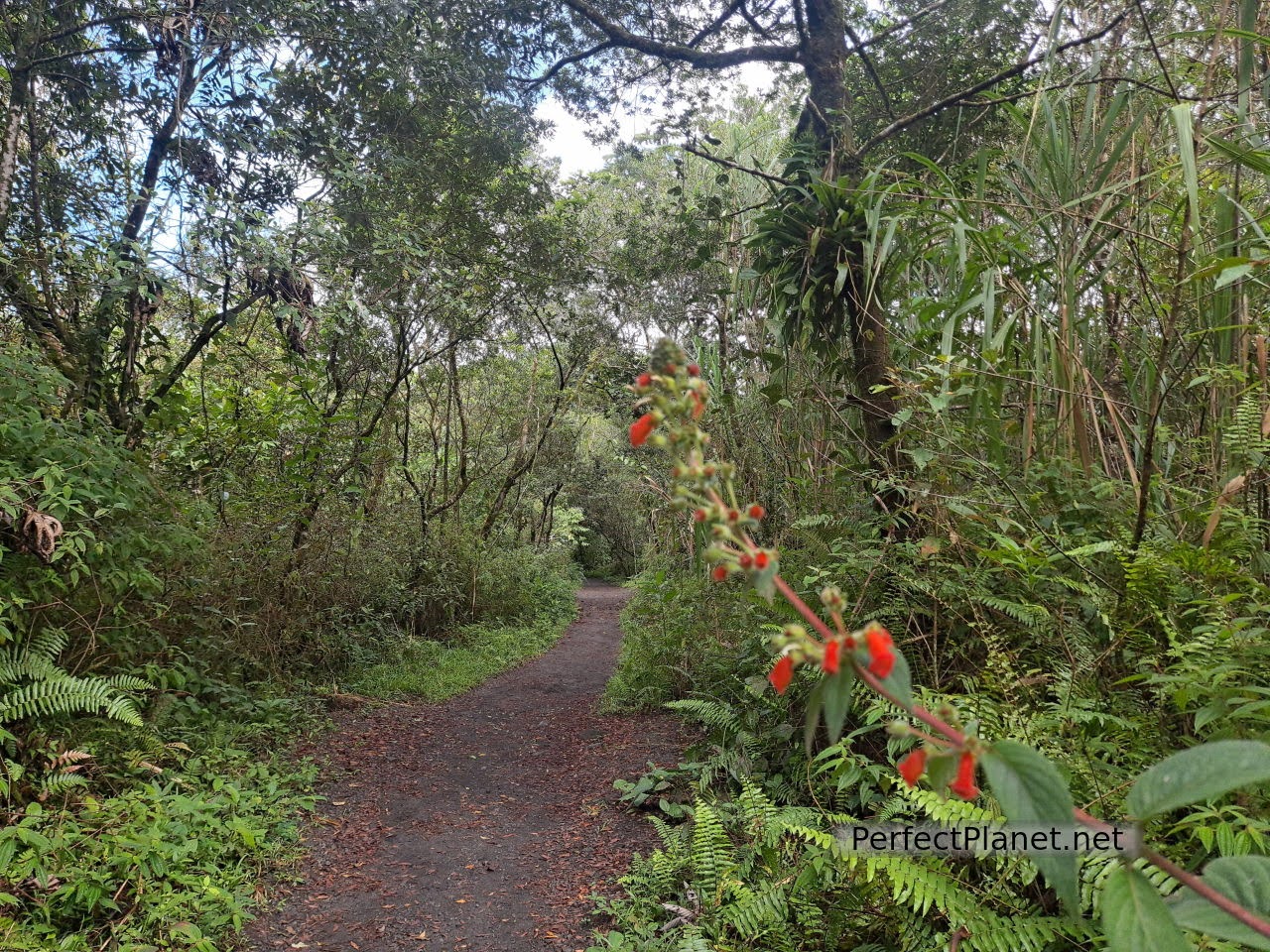
Trail
The Mirador trail is 1.5 km from the entrance hut, it is a fairly wide and well-maintained track that can even be done by car, even if it is not a 4x4.
The Coladas trail is the most beautiful. It is about two kilometres from the car park, practically flat through the forest until you reach some stairs that lead you to the viewpoint. From here you have views of the volcano and Lake Arenal. On clear days you can see two of the smoking craters.
The return is the same way back. You can extend the trail by taking the Ceibo trail where you can see a large ceiba tree that is over 400 years old.
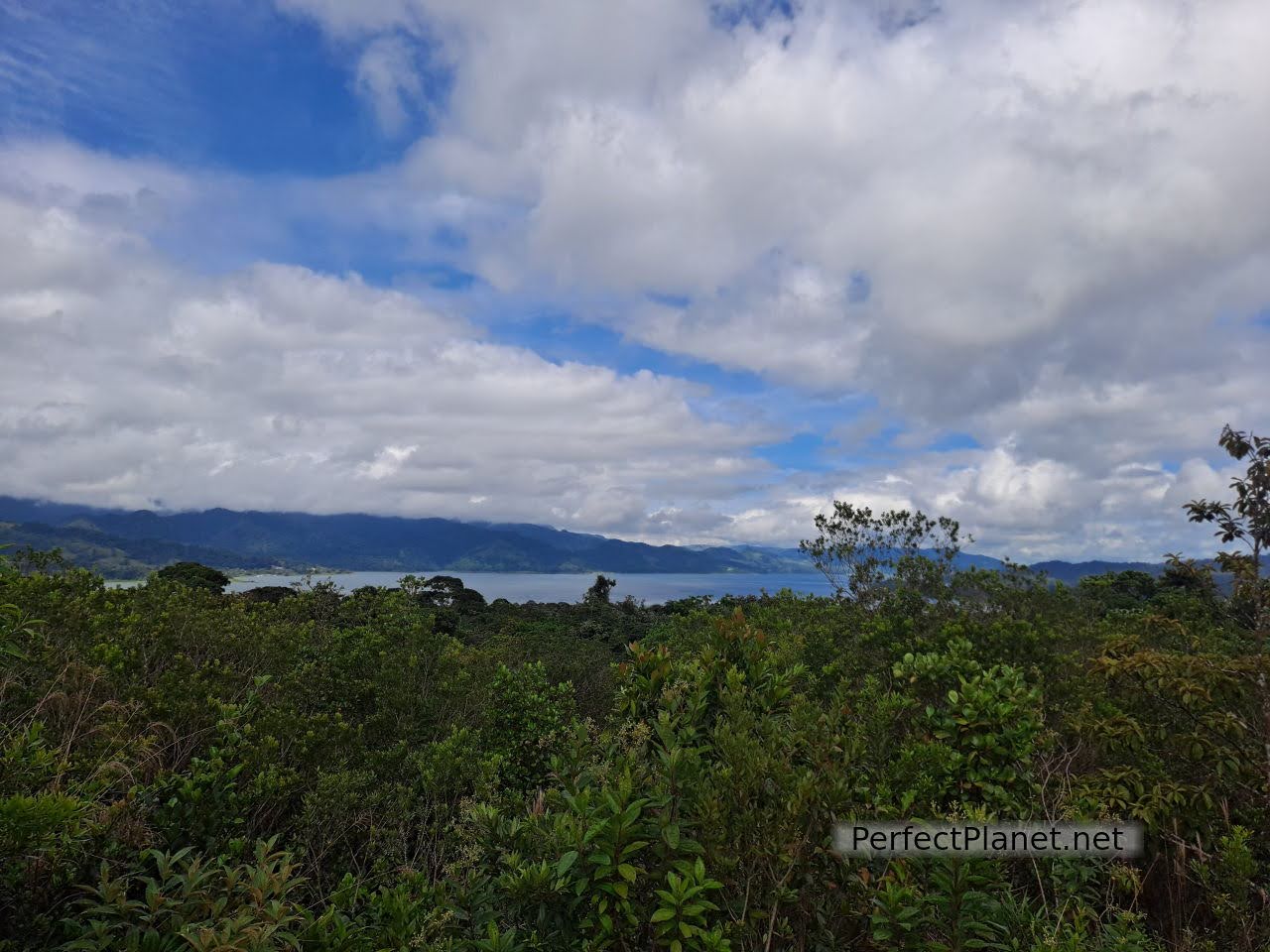
Arenal lake
If you do not access the park by car, from the entrance hut you can take the Heliconias trail that leads you to the end of the car park where the rest of the trails start.
To get to the Península sector you have to leave the Volcán sector and drive along a track in rather poor condition for about two kilometres. If you don't have a 4x4 we don't recommend it. It is best to visit this area at sunset, the sunset over the lake must be beautiful.
What to bring. Apart from water, sunscreen and mosquito repellent, you can walk in trainers or low boots, the trails are very easy although they are not paved.
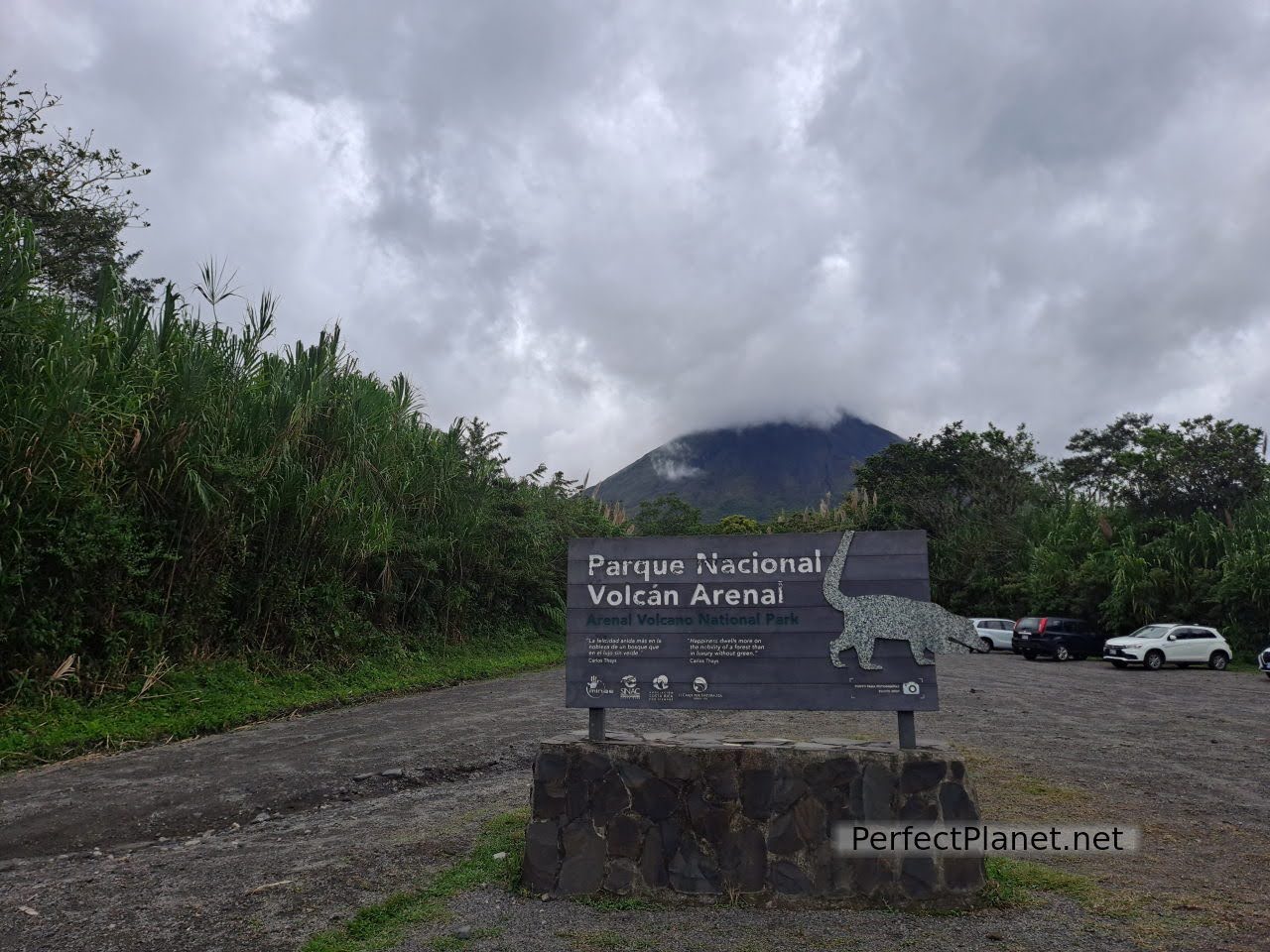
Arenal volcano
In general in Costa Rica the Parks open (7-8 am) quite late for the early morning.
Our feeling about the park. The surroundings are beautiful and although the volcano is impressive, the trails in the Park do not give you a different perspective of the volcano than you can see from other areas outside the Park. If you don't have much time and/or want to save the entrance fee, our advice is to visit the Arenal 1968 reserve (19$/pax) and the Silencio viewpoint or walk the trails with hanging bridges in Mistico Park.
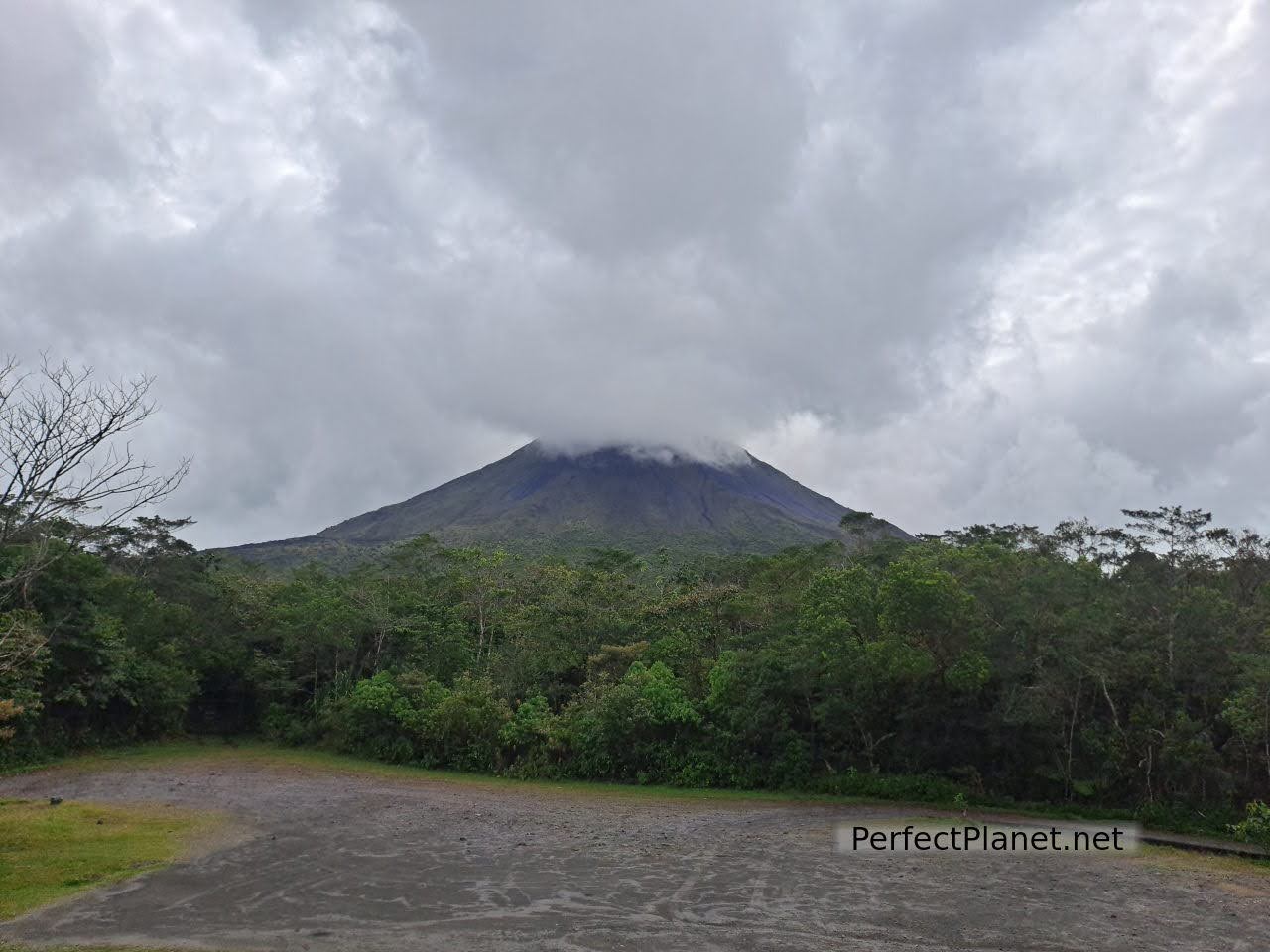
Views from the viewpoint
We continue our journey to our next destination, Volcán Tenorio National Park and Río Celeste. We want to return along the lake but they advise us against it because it would be too long and tedious, a pity because the views are surely worth it. We are advised to return to La Fortuna but before arriving we take the road to the Hotel Arenal Manoa and follow the 1 km track until it joins the Monterrey road. Well, the track is not 1 km but 5 km long and fortunately in the steeper areas there was asphalt and with our car there were no problems, but we would have been better off in a 4x4. In fact we passed by the El Venado caves but we didn't have time to visit them.
We arrived at the entrance of the Tenorio Volcano National Park at 13.00 hours, after a stop on the road to buy 1.5 kgs of mamones ingested for 1.000 colones. How delicious they are!
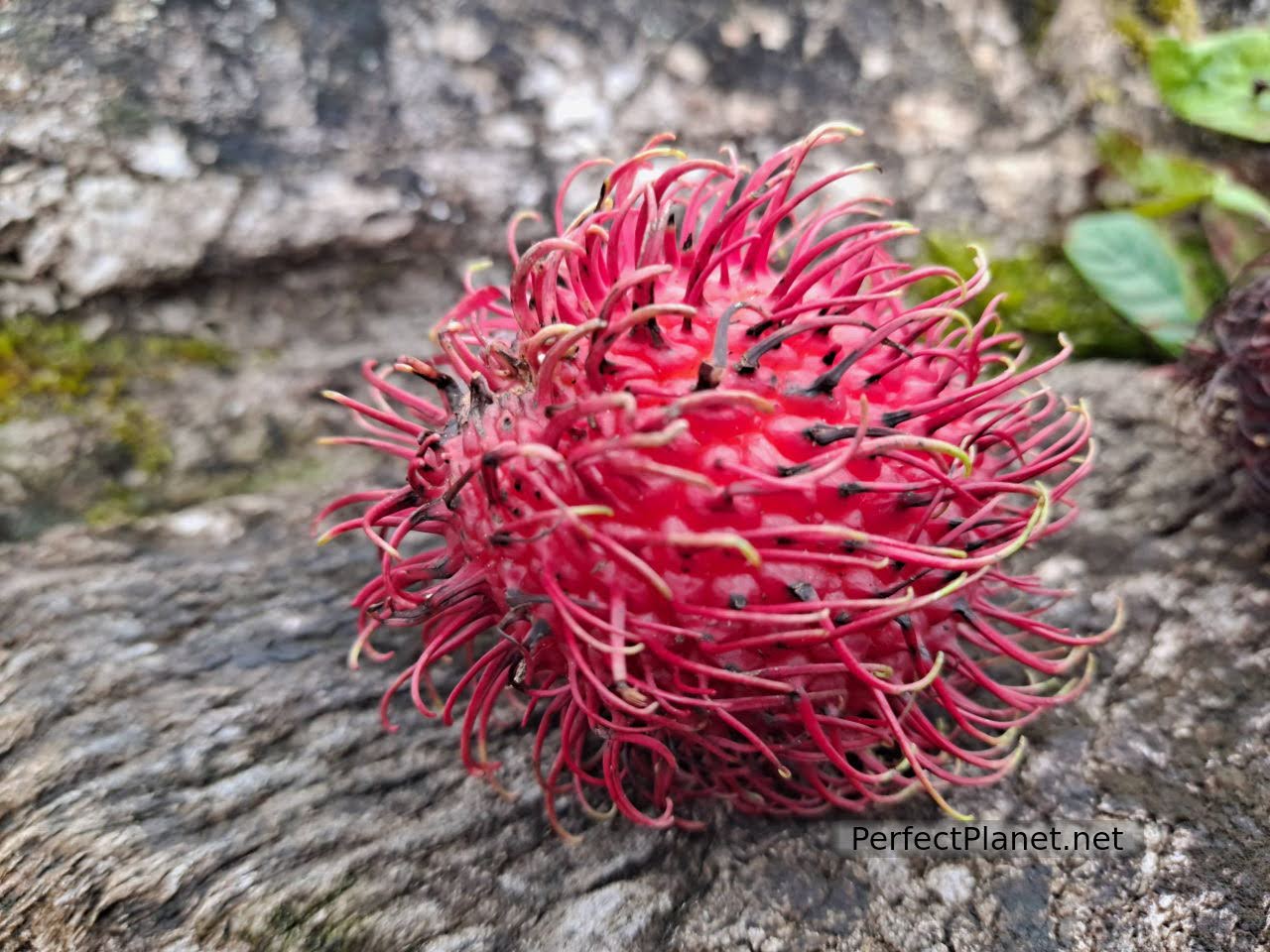
Mamon
When we get to the entrance booth they tell us that the ticket office is closed for half an hour because they are having lunch. So we do the same and go to the restaurant opposite. We are not very hungry so we share a casado with chicken, a beer and a bottle of water.
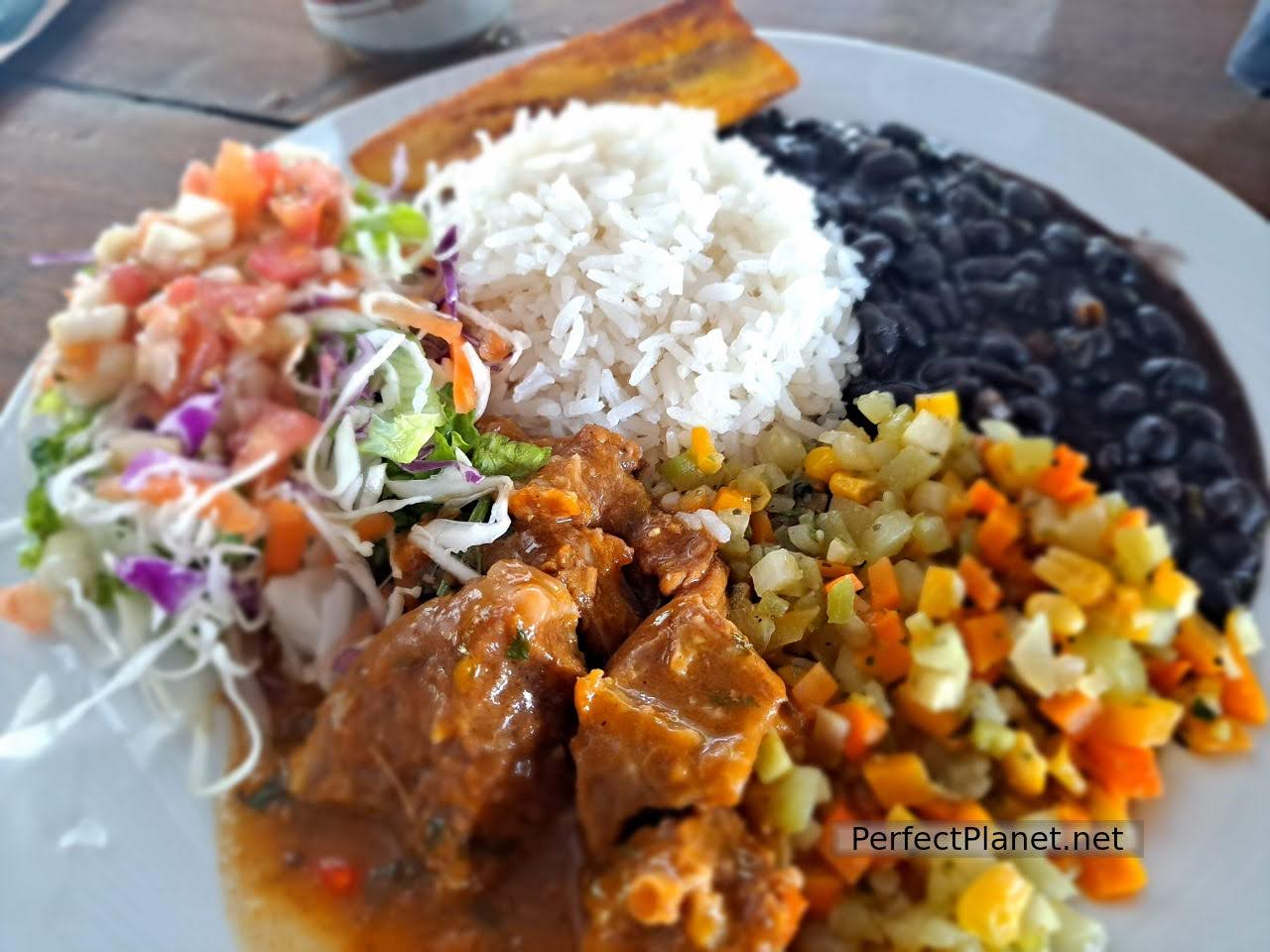
Casado
After lunch we buy the entrance ticket and start our tour through the park. The Tenorio Volcano National Park is famous for the light blue colour of its waters known as the Celeste River. This phenomenon is produced by the incidence of light on minerals called aluminosilicates that are deposited at the bottom of the river. The smaller mineral particles suspended in the river scatter the sunlight, although in this case, due to the size of these particles, only the bluish tones are scattered. This optical phenomenon is known in physics as Mie scattering.
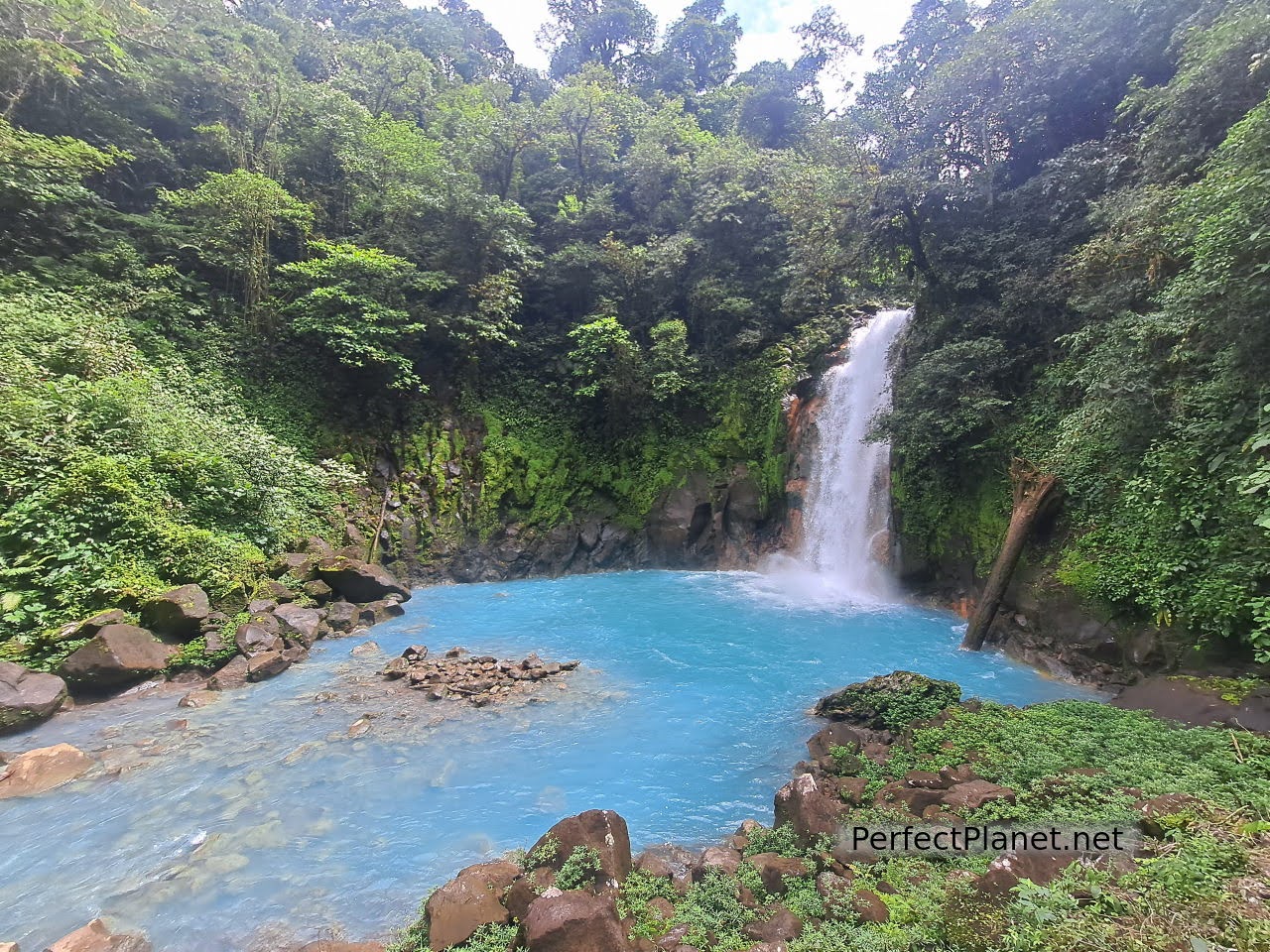
Celeste river waterfall
That's why if there are heavy rains the water is likely to appear brown and although the park is very beautiful it is not so impressive. Our advice, before entering ask the ranger, but if you come from the road from Rio Celeste you have to go over the river on a bridge, at that point you can see the colour of the water.
There is only one official trail inside the park, about 6 kms round trip (300 metres of elevation gain), known as Misterios del Tenorio, and it is really worth it.
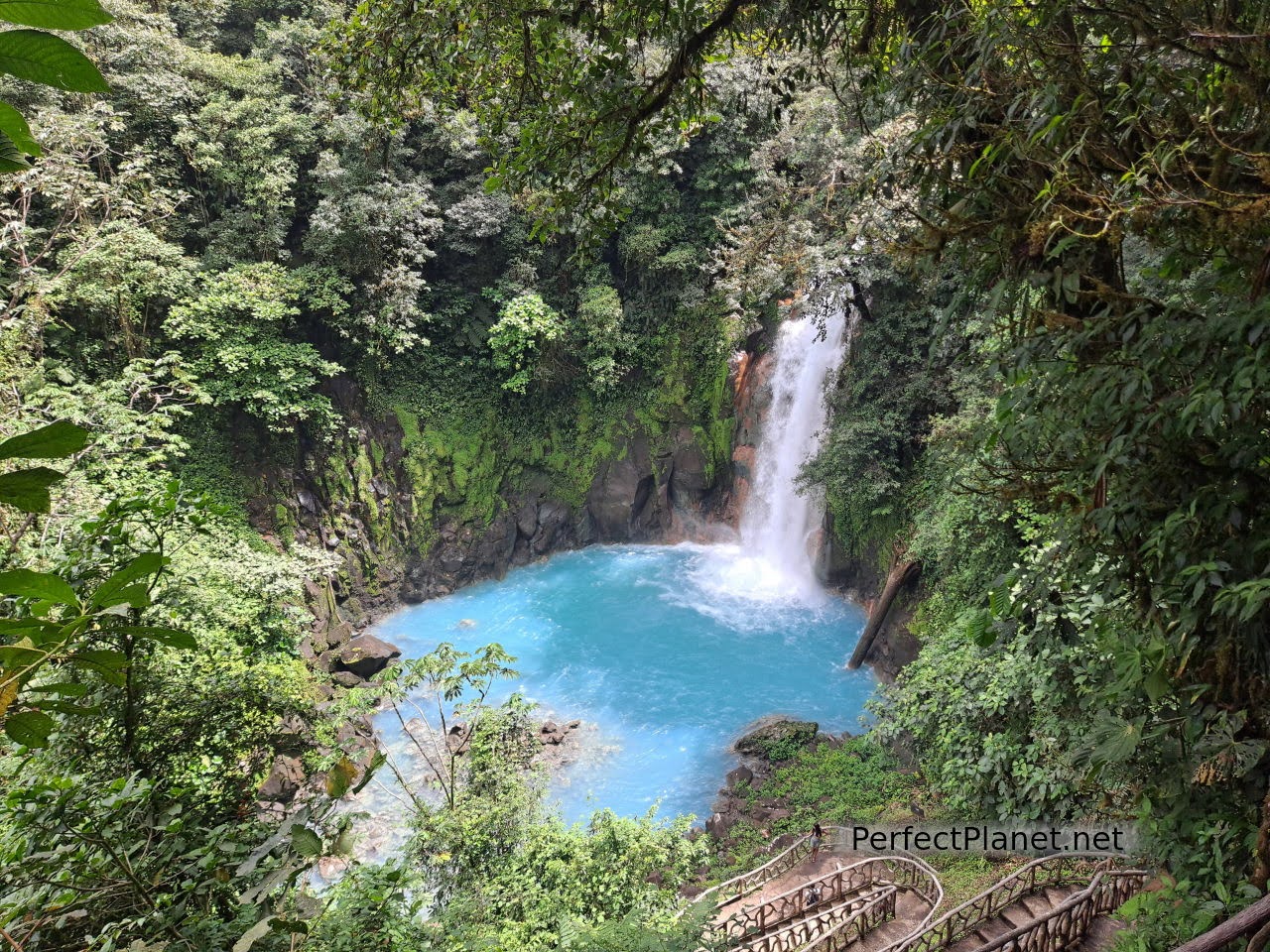
Celeste river waterfall
The first place we come to is the waterfall. To get to the base you have to go down several stairs, but the effort is always worth it.
It is almost 30 metres high, and it is amazing how the sun's rays transform the sky-blue colour, truly amazing.
We continue our walk until we reach the blue lagoon, a small deep blue pool where it is forbidden to bathe. In fact, it is forbidden to bathe in the whole park.
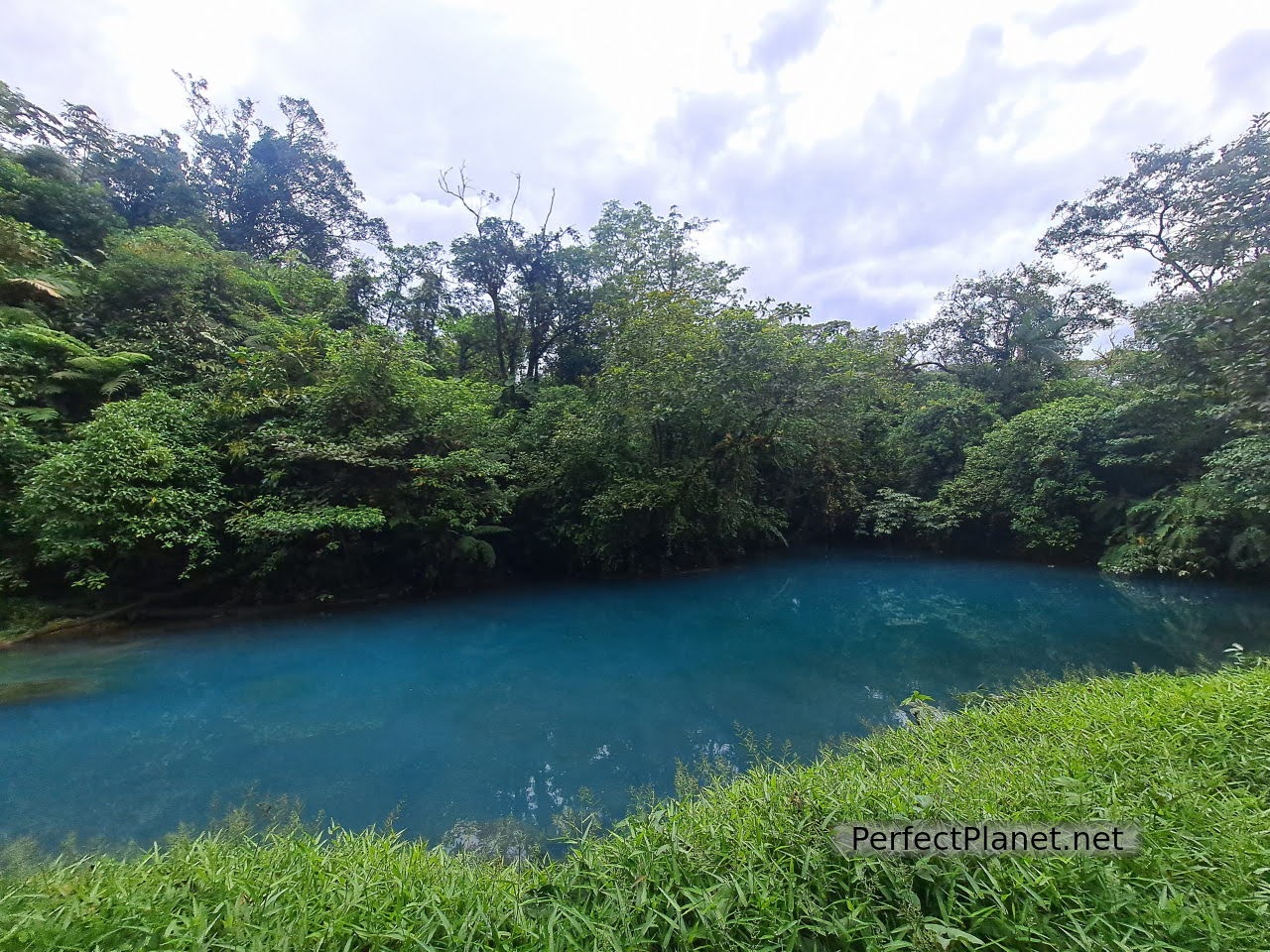
Blue lagoon
The next stop is the "hervideros" or "borbollones". These are fissures through which gases from volcanic activity escape. It also smells quite strong. On the opposite shore a beautiful land tortoise rests.
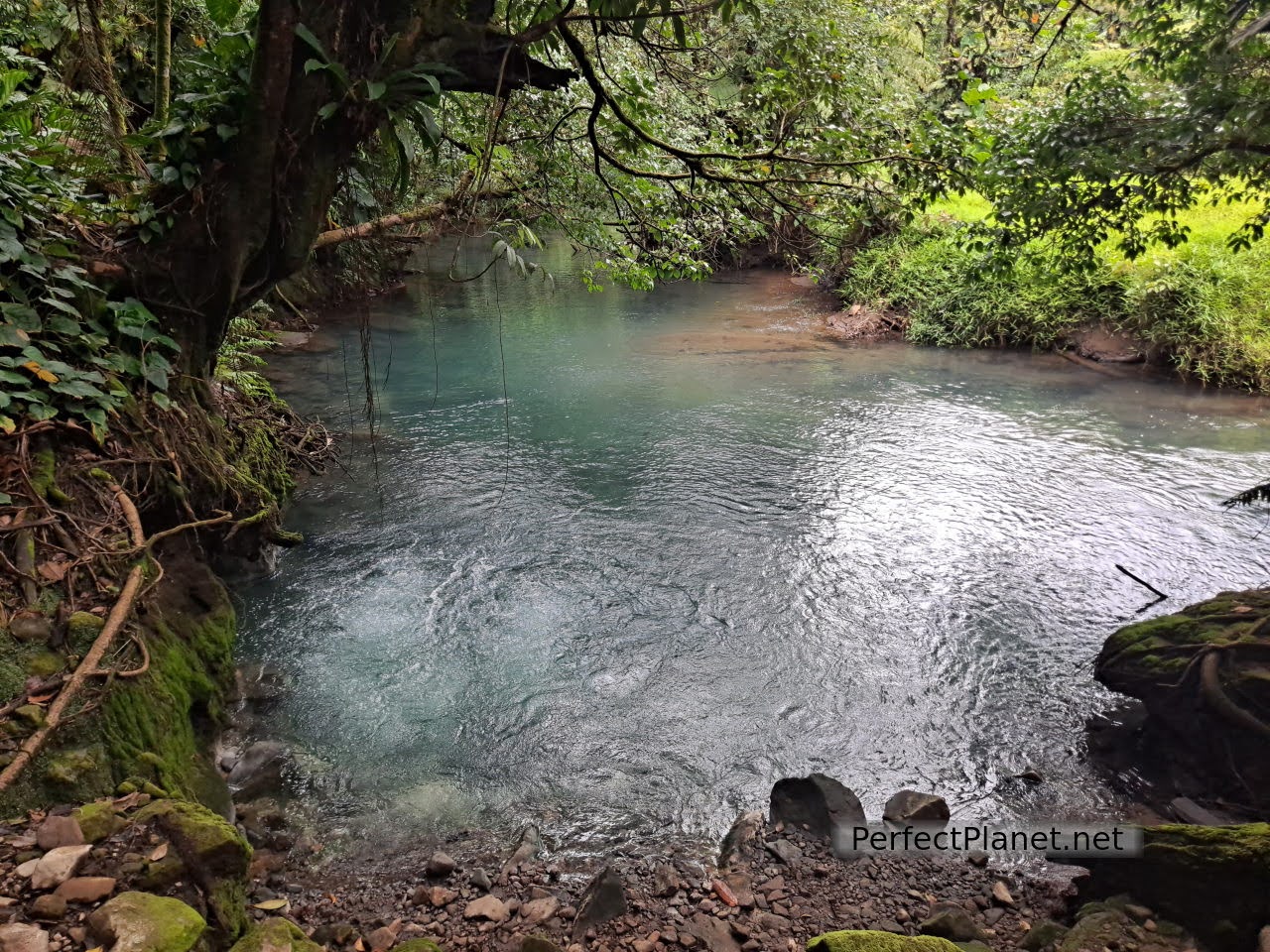
Hervideros
Continuing along the path we reach the viewpoint where on clear days you can see both the Tenorio and Montezuma volcanoes.
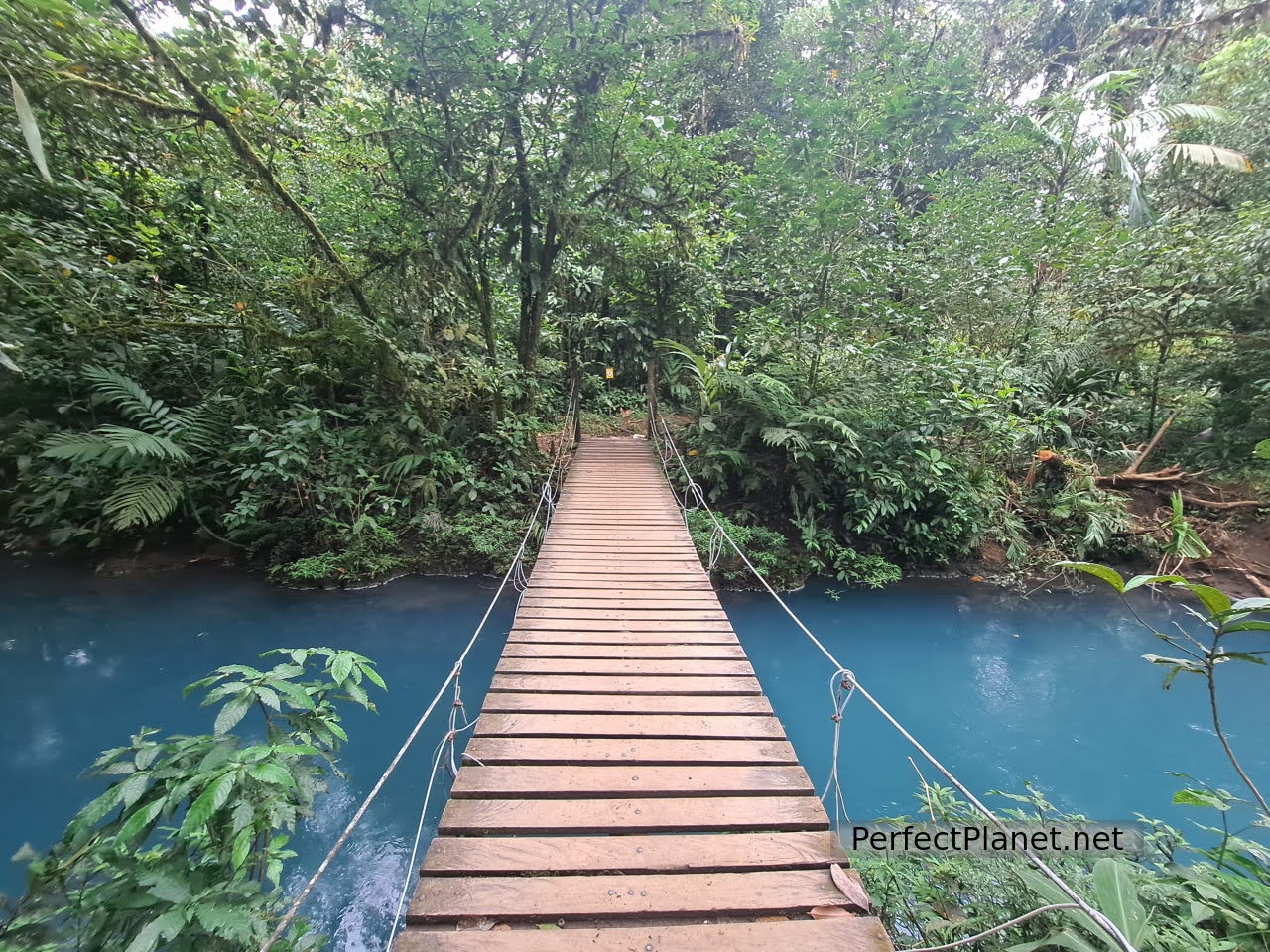
Bridge
A little further on we cross the river over two suspension bridges. The contrast between the colour of the water and the surroundings continues to fascinate us.
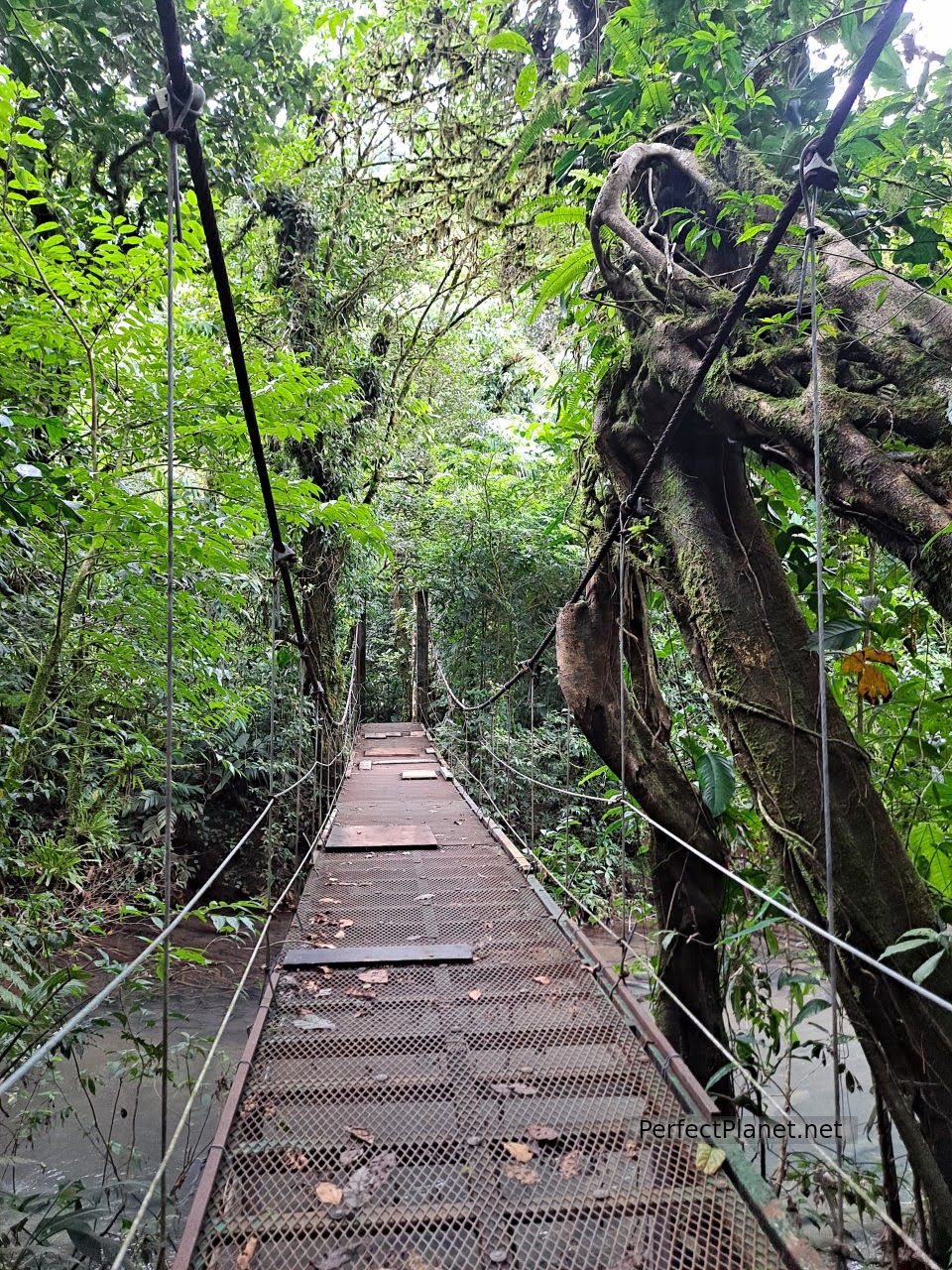
Bridge
The path ends in the area known as El Teñidero. This is where the optical phenomenon begins. Here the waters of the Buenavista river join the waters of the Quebrada Agria. At the bottom of the river you can see the minerals (white in colour) and how from there the water changes colour until it reaches that beautiful intense blue.
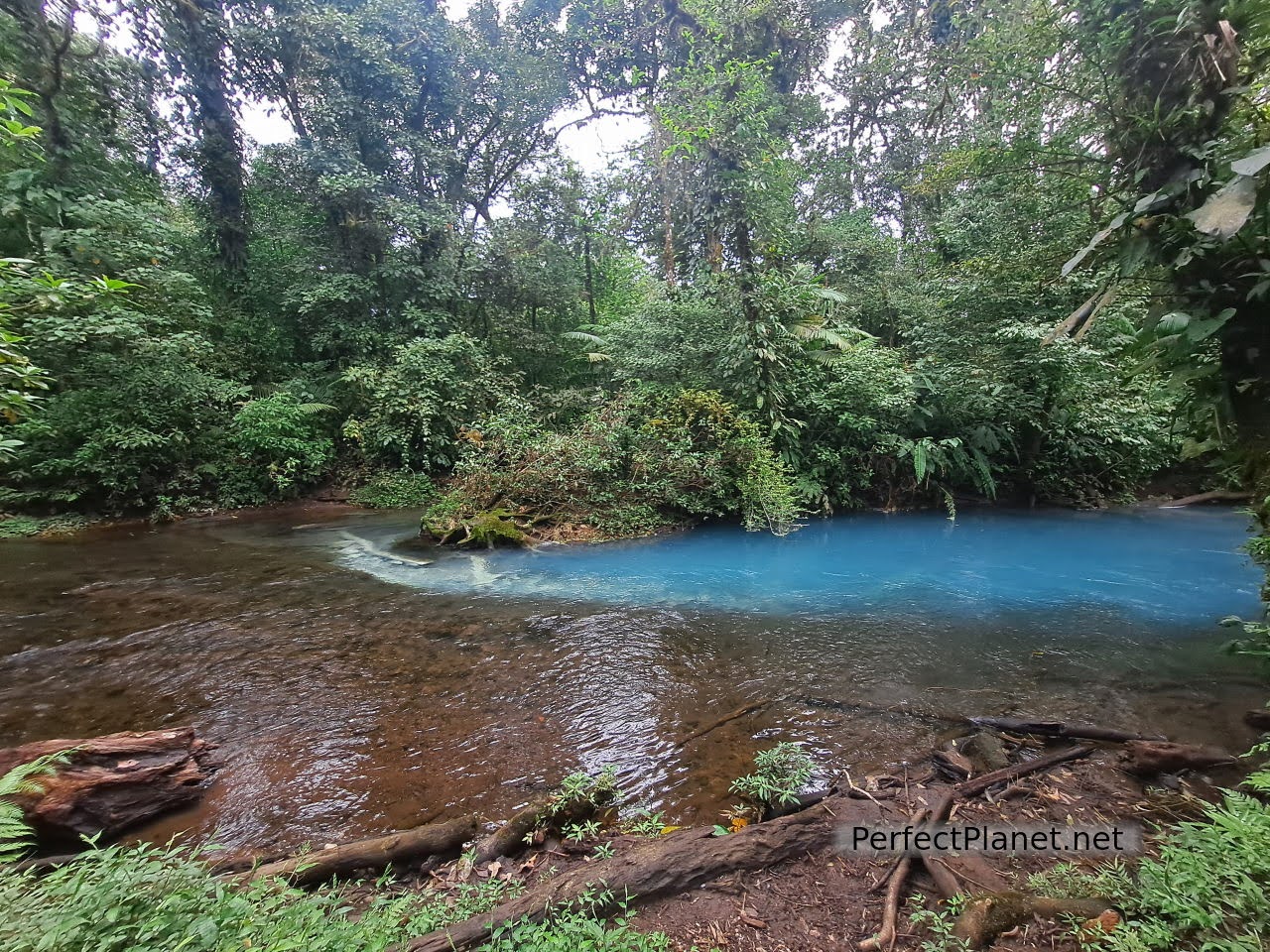
Teñidero
The return journey is along the same path.
What to bring. Apart from water, sunscreen and mosquito repellent, you can walk in trainers or low boots. The trails are easy, the first part to the waterfall has part of the path paved, including the steps to go down to the base of the waterfall. The rest of the trail is unpaved but closed shoes are required.
At the entrance to the Park there is a man selling fruit and we buy a whole pineapple from him (2,000 colones) which he cuts into pieces, and in 10 minutes we have eaten it because it is so delicious. He also gives us a taste of cocoa, you have to suck the pulp and not bite the seed. It has a delicious sweet and bitter taste, I think it's addictive. They sell them for 1,000 colones.
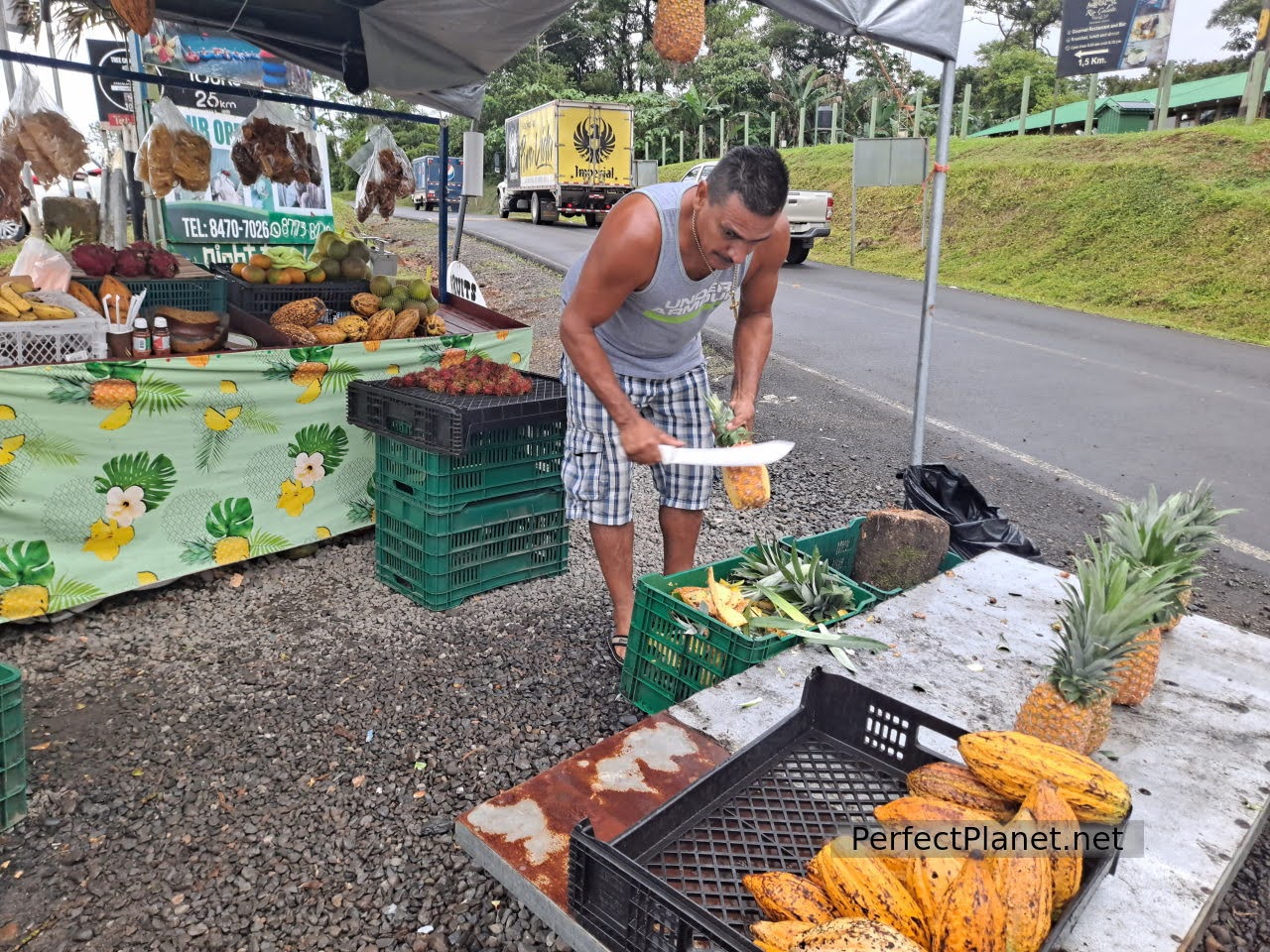
Selling fruit
We take the car and look for our accommodation, Posada Rio Celeste Inn. It is on the main road next to a soda owned by the owners. The room is a very rustic but clean cabin for 4 people with a bathroom and a small porch with a bench. If you are lucky you see toucans coming to eat the fruits of a nearby tree and if you don't there are always other colourful birds hanging around.
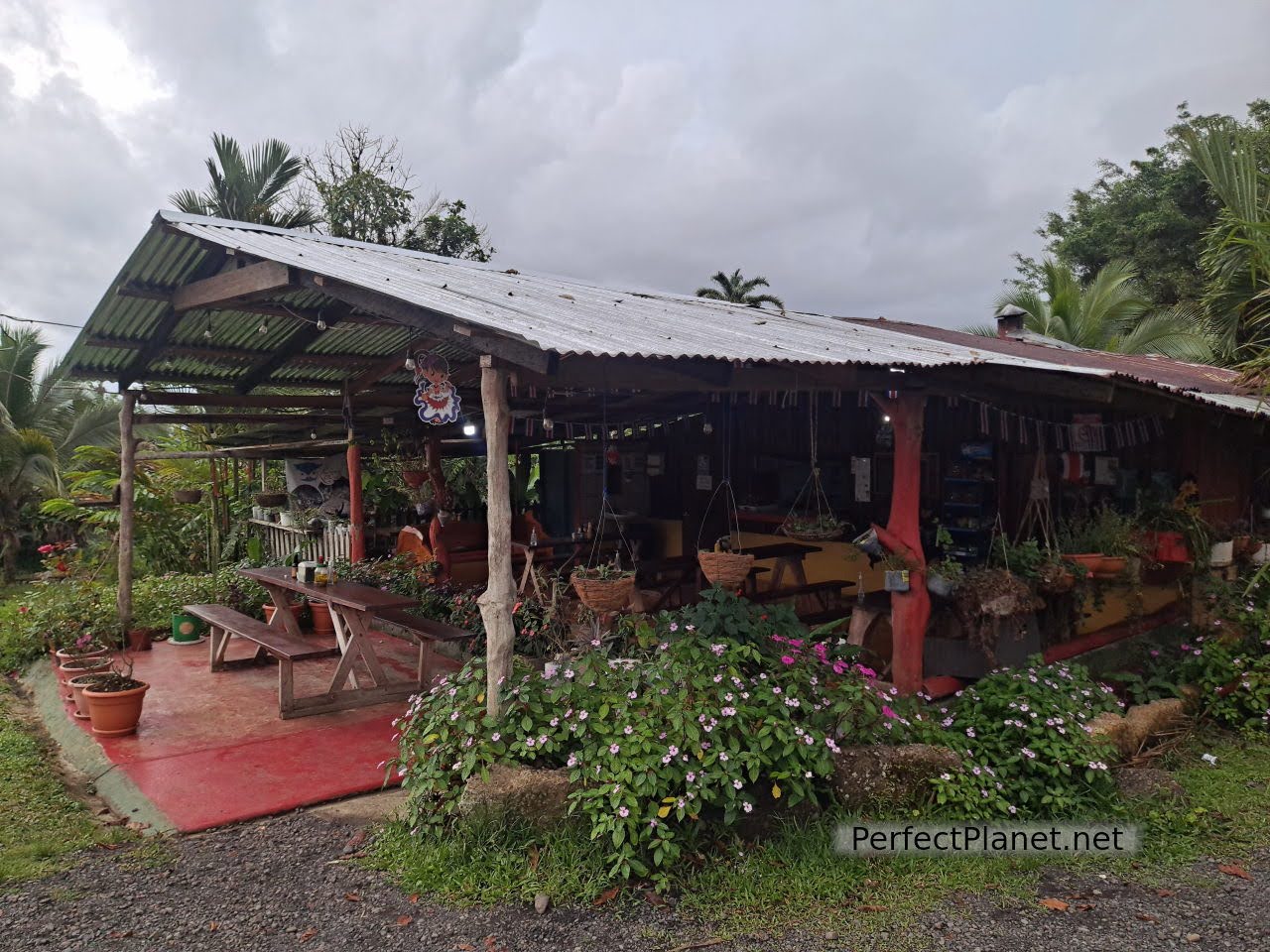
Soda
The sky clears completely and we enjoy a beautiful sunset.
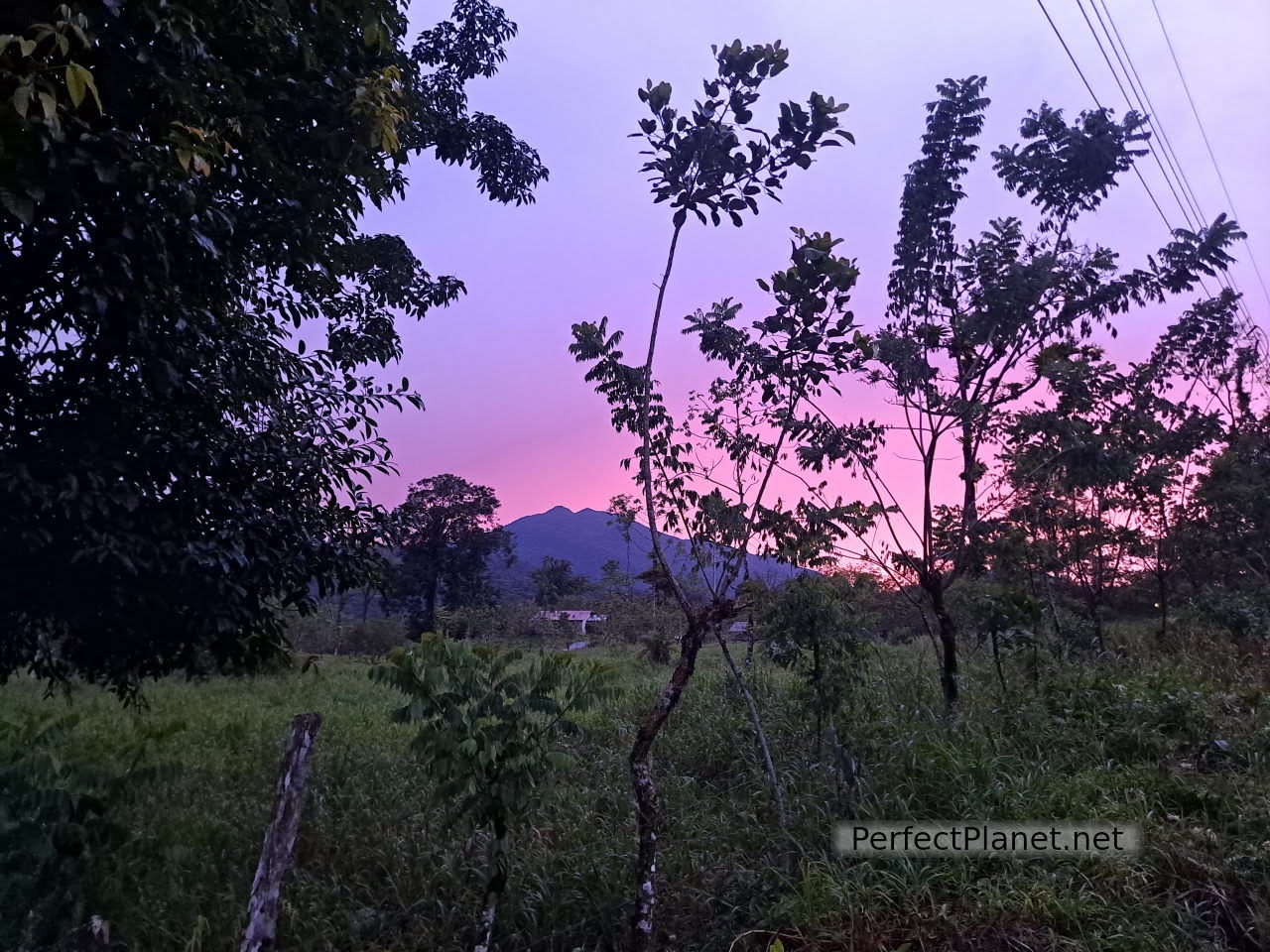
Sunset
We had dinner at La Soda. It's the first time we've tried chifrijo and we love it. From now on it is going to be our favourite dish. Chifrijo is a bean and rice base, with bean paste, in this case shredded chicken and gallo pinto with homemade nachos (sometimes presented in a corn basket). We also ordered a shredded chicken burger which is amazing. This lady's hand in the kitchen is brutal. You can pay by card (colones only) or cash. It closes at 7pm.
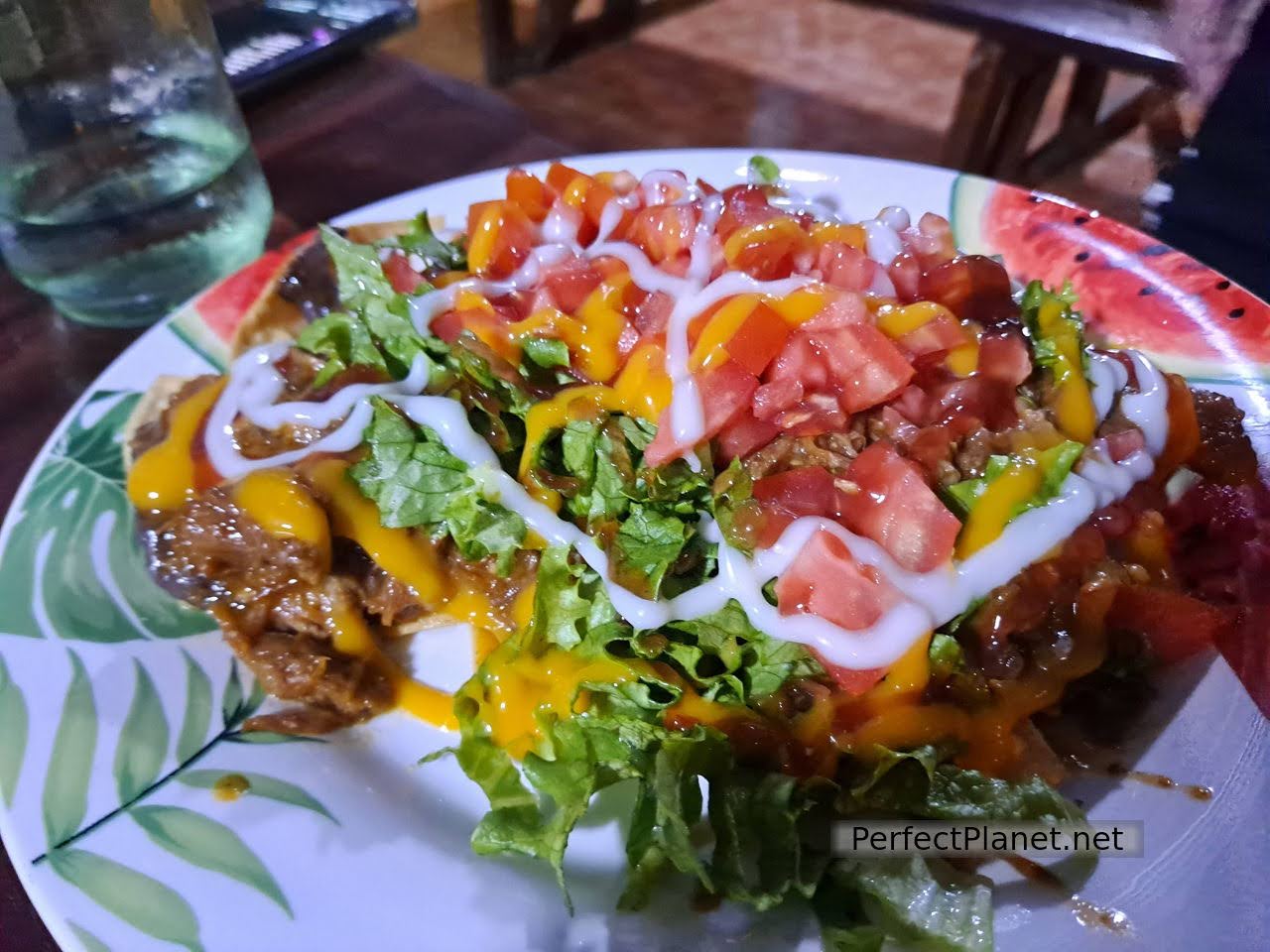
Chifrijo
We arranged with the woman to prepare breakfast for us at 7am the next day, even though she opens at 7.30am. Breakfast includes a gallo pinto with chopped eggs (like scrambled eggs), a gallo de salchichón (an omelette with a grilled sausage), coffee and chocolate. It's all incredible. If you pass by please stop by.
Breakfast bakery: 3.900 colones (1.200 colones coffee, 2 empanadas and 1 donut)
Entrance fee Arenal Volcano National Park: 15$/pax (+13% VAT), parking included
Tenorio Volcano National Park: 12$ (+13%VAT) + 2.000 colones parking included
Lunch: Soda El Parque,8.000 colones (1 casado, 1 beer, 1 bottle of water)
Accommodation: Cabinas Rio Celeste Inn, cabin with quadruple room, bathroom and breakfast included for 31.61€/night for 2 pax.
Dinner: Soda Rio Celeste Inn 6.500 colones
- Log in to post comments

